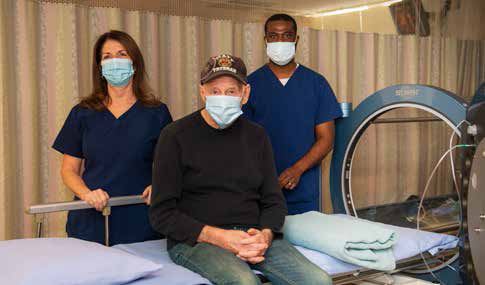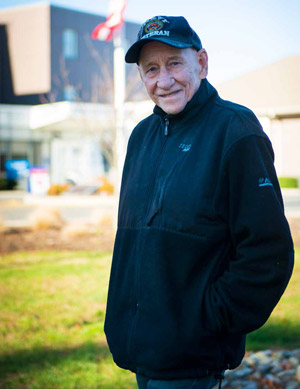Right now, I feel like I’m on top of the world. I feel great

When Joe Bruno developed a terrible toothache in early 2020, his dentist removed the abscessed lower left molar. Unfortunately, one month later, he was still in pain. Turns out, the hole in his gum had become infected, leaving Joe with an aching, pea-size lump in his jaw and a numb bottom lip.
Over the next few months, Joe’s dentist tried treating the problem with antibiotics. When that didn’t help, Joe, 86, of Whiting consulted a dental surgeon who discovered an even bigger problem. X-rays revealed bone decay in Joe’s jaw, a result of damage from the 45 radiation treatments he had undergone almost a decade earlier for throat cancer. The radiation had cut off blood flow to the bone, which caused the bone to disintegrate. Without further intervention, Joe was at risk for a broken jaw.
Helping the Body Heal

Thankfully, Joe was referred to Monmouth Medical Center Southern Campus (MMCSC) to undergo two months of what’s known as hyperbaric oxygen therapy. The treatments—42 sessions spent inhaling 100 percent oxygen in a hyperbaric chamber—helped stimulate healthy blood flow to Joe’s jaw and promote healing and stronger bone.
“Hyperbaric oxygen therapy is twice the atmospheric pressure, which means a tremendous amount of oxygen is delivered to the tissues,” says Johnny Larsen, DO, Medical Director for Hyperbaric Medicine at MMCSC, who oversaw Joe’s care. “When you have a nonhealing wound or radiation injury, the tissue is deficient in oxygen. With this treatment, the oxygen helps stimulate the growth of new blood vessels and connective tissue and activates cells that fight infection. It induces healing.”
 Joe started the hyperbaric oxygen treatments in November 2020 and happily got relief within a month. “The treatments made me feel so much better,” he says. “I don’t have any pain at all now. I have a little numbness around my front teeth, but it doesn’t bother me at all. The bump is gone.” In December, while partway through his hyperbaric oxygen treatments, Joe had an additional dental surgery to scrape the bone and clean up the area where the tooth had been pulled.
Joe started the hyperbaric oxygen treatments in November 2020 and happily got relief within a month. “The treatments made me feel so much better,” he says. “I don’t have any pain at all now. I have a little numbness around my front teeth, but it doesn’t bother me at all. The bump is gone.” In December, while partway through his hyperbaric oxygen treatments, Joe had an additional dental surgery to scrape the bone and clean up the area where the tooth had been pulled.
A Well-Tolerated Treatment
Patients typically have five hyperbaric oxygen treatments per week for about two hours at a time, says Cheryl Munroe, RN, BSN, CCM, Area Director for the Center for Wound Healing and Hyperbaric Medicine at MMCSC, who treated Joe. After changing into a cotton gown, patients step inside an acrylic chamber. They’re given blankets and a pillow, and they can choose to watch a show or movie on a flat-screen TV during the treatment. The treatment lasts for 90 minutes.
Most patients tolerate the treatment well, says Larsen. Temporary side effects include blurry vision and bruising to the ear drums. In addition, patients’ ears may feel full during the treatment. “We tell them to plan for the same kind of sensations we get when we fly in a plane,” says Munroe. Patients can hold their nose and blow to relieve the pressure. Reassuringly, they can also talk to their doctor or nurse via phone at any time while in the chamber. Joe didn’t experience any side effects and is grateful that his mouth has finally healed. “This was bothering me for a whole year,” he says. “Right now, I feel like I’m on top of the world. I feel great.”
Could You Benefit From Hyperbaric Oxygen?Hyperbaric oxygen treatments are frequently used at Monmouth Medical Center Southern Campus (MMCSC) to help repair nonhealing wounds, such as diabetic foot ulcers. Patients with nonhealing wounds may need 30 or more treatment sessions to see results, says Johnny Larsen, DO, Medical Director for Hyperbaric Medicine at MMCSC. |
For more information about the Wound Care Center at Monmouth Medical Center Southern Campus, call 732.886.4100.